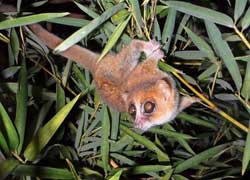German scientists discover two new primate species

Microcebus marohita in the forests of Madagascar<br>Photo: Bellarmin Ramahefasoa<br>
The new species have been named “Microcebus tanosi“ and “Microcebus marohita“. Like all lemur species, they live exclusively on Madagascar. This raises the number of known mouse lemur species to 20. At the suggestion of primatologist Peter Kappeler, Microcebus marohita has already been classified as “endangered” in the new Red List of endangered species.
The scientists first describe the new species in the “International Journal of Primatology“, which will be published online ahead of print on March 26th. The small primates had already been discovered during fieldwork in the rain forests of Madagascar in 2003 and 2007, but are only now formally described as new species for the first time.
Microcebus tanosi is relatively large compared to other known mouse lemur species and has a reddish head. Its fur is patterned in dark brown on the back with a dark stripe along the spine. On the belly, the fur is colored in fawn and grey. The species name is derived from the region Anosy in the southeast of Madagascar where the animal was discovered.
Microcebus marohita has a long, bushy tail and large hind feet. The brownish colored primate is characterized by its small ears and is the largest of all mouse lemurs. Microcebus marohita was named after the forest in which it was discovered. The term “marohita” means “many views” in Malagasy.
Mouse lemurs are a genus which is endemic to Madagascar and includes the smallest primate of the world. Already in 2010, the same group of scientists discovered that there must be more mouse lemur species than were known at the time. The researchers had analyzed tissue samples of mouse lemurs for their maternal DNA (mtDNA) and nuclear DNA (nDNA) variation. With this study, they discovered several new species, which have been known only genetically until the recent publication in the “International Journal of Primatology“. The team of Peter Kappeler now assigned names to two of these “cryptic species”.
During fieldwork in 2012, the first author Rodin Rasoloarison from the German Primate Center discovered that the Forêt de Marohita has been seriously fragmented and destroyed. As Microcebus marohita is currently only known from this region, he and Peter Kappeler recommended classification of this species as “endangered” to the International Union for Conservation of Nature Species Survival Commission (IUCN/SSC) during a workshop in Madagascar held in 2012. Thus, Microcebus marohita was classified as one of the most endangered animal species even before its official original description.
According to the IUCN, Malagasy lemurs are the most endangered group of mammals today. Deforestation and poaching are the main threats to lemur survival in one of the poorest countries in the world that has been plagued by political instability for years.
Original publication:
Rodin M. Rasoloarison, David W. Weisrock, Anne D. Yoder, Daniel Rakotondravony & Peter M. Kappeler (2013): Two New Species of Mouse Lemurs (Cheirogaleidae: Microcebus) from Eastern Madagascar. International Journal of Primatology. Epub ahead of print. DOI: 10.1007/s10764-013-9672-1.
Contact
Prof. Dr. Peter M. Kappeler
Tel: +49 551 3851-376
E-Mail: pkappel@gwdg.de
Astrid Slizewski (public relations department)
Tel: +49 551 3851-359
E-Mail: aslizewski@dpz.eu
The German Primate Center (DPZ) in Göttingen, Germany, conducts basic research on and with primates in the areas of infectious diseases, neurosciences and organismic biology. In addition, it operates four field stations abroad and is a competence and reference center for primate research. The DPZ is one of the 86 research and infrastructure institutions of the Leibnitz Association in Germany.
Media Contact
More Information:
http://www.dpz.euAll latest news from the category: Life Sciences and Chemistry
Articles and reports from the Life Sciences and chemistry area deal with applied and basic research into modern biology, chemistry and human medicine.
Valuable information can be found on a range of life sciences fields including bacteriology, biochemistry, bionics, bioinformatics, biophysics, biotechnology, genetics, geobotany, human biology, marine biology, microbiology, molecular biology, cellular biology, zoology, bioinorganic chemistry, microchemistry and environmental chemistry.
Newest articles

Combatting disruptive ‘noise’ in quantum communication
In a significant milestone for quantum communication technology, an experiment has demonstrated how networks can be leveraged to combat disruptive ‘noise’ in quantum communications. The international effort led by researchers…

Stretchable quantum dot display
Intrinsically stretchable quantum dot-based light-emitting diodes achieved record-breaking performance. A team of South Korean scientists led by Professor KIM Dae-Hyeong of the Center for Nanoparticle Research within the Institute for…

Internet can achieve quantum speed with light saved as sound
Researchers at the University of Copenhagen’s Niels Bohr Institute have developed a new way to create quantum memory: A small drum can store data sent with light in its sonic…





















